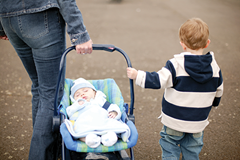Children and care
 Reported physical abuse against children has nearly doubled in the last five years. agendaNi reports on the growing problem and how care can be improved.
Reported physical abuse against children has nearly doubled in the last five years. agendaNi reports on the growing problem and how care can be improved.
The numbers of children being referred to social services, registered for child protection or looked after outside their immediate family have all increased since 2007. Ministers have pledged to keep child protection as a priority during this Assembly term.
Child protection cases involving physical abuse increased from 357 to 610 between 2007 and 2012. A total of 35,516 referrals were made to social services in 2011-2012, involving 28,496 children. Around three-quarters of referred children require more intervention from social workers which can involve working with the family or, in more serious cases, removing a child from his or her parents.
In March of this year, 2,127 children were registered for child protection. Belfast has the largest overall population but the South Eastern area had the largest single number of registered children (529). This included a disproportionate number of cases (393) referred to social workers by the police. The Northern area now has almost the same number of registered children as Belfast: 458 compared to 474.
At the same time, a total of 2,644 children were being looked after in care. The proportion receiving foster care has increased since 2007, from 59 per cent to 74 per cent. Children in care are generally looked after for one to three years but 262 children (134 boys and 128 girls) have been in care for 10 years or more.
The Department of Health, Social Services and Public Safety is unsure of the reason for the increase, which could indicate an actual increase in cases or better awareness, reporting and enforcement.
“Safeguarding children and vulnerable adults is a Programme for Government priority,” a spokeswoman stated. “The department will bring forward a package of measures over the lifetime of the programme to improve safeguarding outcomes for vulnerable groups, including children.”
In practice, this will involve publishing an updated domestic and sexual violence and abuse strategy by April 2013, opening a new sexual assault referral centre at Antrim Area Hospital by April 2014 and updating the child safeguarding policy framework by April 2015.
Adoption is a potential outcome for some children in care but a child may, alternatively, return to their original home or continue to live with relatives or foster carers. 106 adoption orders were granted in 2010-2011, of which 62 transferred a child from one family to another family within Northern Ireland.
A draft Adoption (and Children) Bill was approved by the Executive in May 2010. It includes statutory timetables for court proceedings and the option of special guardianship, which allows birth parents to have some continued responsibility.
At present, married couples and single people aged over 21 can adopt a child in Northern Ireland. The Bill, though, has been held up by legal proceedings seeking to change the criteria for adopters. The High Court found against the current policy on 19 October but Health Minister Edwin Poots plans to appeal.
This case has led to heated debate as both sides claim to represent the rights of the child. The Human Rights Commission claims that allowing unmarried (including same-sex) couples to apply will increase the number of potential adopters. That view is supported by Sinn Féin, the SDLP and Alliance.
The DUP and the main churches contend that supportive marriages are the best setting for raising children and want to encourage more married people to adopt. The Centre for Social Justice’s Breakthrough Britain study reported that 43 per cent of co-habiting parents split up before a child’s fifth birthday, compared with 8 per cent of married parents. The UUP is awaiting the potential appeal’s outcome before deciding its policy.
Ulster Unionist MLA Tom Elliott, an adoptive parent, has said: “Out of all this process, we must remember that the children in these processes must come first and foremost and, whatever decisions are taken, that it is the children’s well-being that are most important.”





